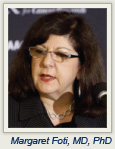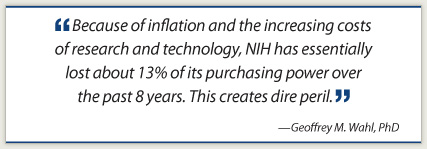December 23, 2011, marked the 40th anniversary of the National Cancer Act. To mark that occasion, on February 2, the American Association for Cancer Research (AACR) held a Congressional briefing, attended by about 100 legislative aides, to remind Congress that the war on cancer is far from over. Significant strides have been made, said Margaret Foti, PhD, MD (hc), CEO of AACR, and the era of personalized medicine promises renewed hope. But the research needed to turn that hope into reality costs a fortune.
 Dr. Foti added that 12 million cancer survivors are alive today because of Congress’s strong bipartisan support of cancer research. Two of those supporters, Rep. Brian Bilbray (R-CA) and Rep. Rosa DeLauro (D-CT), spoke briefly to confirm their continued belief in the funding effort. Both have been touched personally by cancer: Rep. Bilbray’s daughter is undergoing treatment for malignant melanoma, and Rep. DeLauro is a long-time survivor of ovarian cancer.
Dr. Foti added that 12 million cancer survivors are alive today because of Congress’s strong bipartisan support of cancer research. Two of those supporters, Rep. Brian Bilbray (R-CA) and Rep. Rosa DeLauro (D-CT), spoke briefly to confirm their continued belief in the funding effort. Both have been touched personally by cancer: Rep. Bilbray’s daughter is undergoing treatment for malignant melanoma, and Rep. DeLauro is a long-time survivor of ovarian cancer.
View from the Front Line
Judy E. Garber, MD, Director of the Center for Cancer Genetics and Prevention, Dana-Farber Cancer Institute, and AACR President, said, “Nearly every treatment I can offer as a clinician has been discovered in the past 40 years—almost all, at least in part, because of the extraordinary commitment by Congress. We have been able to decrease cancer deaths by 21% in men and 12.4% in women since 1990, and the average 5-year survival rate is 68% for adults and 80% for children.”
She said that as a result of the publicly funded Human Genome Project, more than 290 cancer-related genes have been discovered. “But knowing that these genes exist and contribute to the cause of cancer is not nearly enough. We need to learn how tumor environment regulates cell behavior, and how that environment supports tumor growth. We need to better understand metastasis, one of the thorniest problems in cancer research, and interaction with the immune system.”
Personalized Medicine Is the Future
 Cancer treatment is moving away from the one-size-fits-all model to more “personalized” medicine, in which the unique molecular components of a patient’s tumor dictate the most efficacious therapy.
Cancer treatment is moving away from the one-size-fits-all model to more “personalized” medicine, in which the unique molecular components of a patient’s tumor dictate the most efficacious therapy.
“We used to think that the organ from which the cancer derived defined treatment, but as a result of technology used to sequence cancer genomes, we now understand that many of the exploitable targets in a cancer are defined by the intrinsic factors that drive that specific tumor’s development,” said Dr. Garber.
The challenge, she said, is to develop new drugs designed specifically to block identified malfunctions. So far, FDA has approved 32 such agents.
Keith Flaherty, MD, Director of Developmental Therapeutics, Massachusetts General Hospital Cancer Center, said that genetic screening has revealed that about half of all melanoma patients carry a mutation of a specific RAF gene, called BRAF. Of these, he continued, almost all (90%) have a mutation known as BRAF V600E, which causes the BRAF protein to continually activate its signaling network, causing cancer.
Dr. Flaherty and his colleagues developed vemurafenib (Zelboraf), which inhibits overactive BRAF V600E, thus blocking its ability to cause cancer. It is the first example of a drug discovered by systematically searching for mutations associated with a particular cancer—like finding a needle in a haystack, he said.
Clinical trials compared vemurafenib with the standard of care and confirmed that the drug reduces disease progression by 74% and the risk of death by 63%. It received FDA approval in August 2011.
Unfortunately, said Dr. Flaherty, “The average time to disease progression is about 6 months. Our recent findings suggest that ipilumumab (Yervoy) should be combined with vemurafenib, but we worry that giving ipilumumab after vemurafenib would not be a good idea.”
Since the same mutation found in melanoma patients occurs in other types of cancer (thyroid, ovarian, colorectal, and prostate tumors), other uses for vemurafenib may be found.
Another Dramatic New Treatment
Roslyn Milstein Meyer, PhD, Assistant Clinical Professor of Psychiatry, Yale University School of Medicine, was already gravely ill when she was diagnosed with stage IV malignant melanoma at age 56. Her oncologist suggested an NIH trial for adoptive immunotherapy using tumor-infiltrating lymphocytes.
“The investigators planned to remove my malignant lymph node and isolate lymphocytes that attacked the tumor. They would then clone these cells into the billions and return them to me,” Dr. Meyer explained.
“Unfortunately, they were unable to grow the cells for tumor-infiltrating lymphocyte treatment [this happens to about 40% of patients], but as we were waiting for the cells to grow, I was put on high-dose interleukin-2 [IL-2, Proleukin]. This is a tough treatment with only a 10% to 20% response rate. I was one of the lucky ones, and my tumors began to shrink.”
Dr. Meyer hoped this would turn into a cure, but it did not, and over the next 3 years, she “rode a roller coaster of recurrence.” But she persevered because she believed that the longer she lived, the more likely she would be to find a successful treatment.
And she did. Three years after diagnosis, Dr. Meyer was the first person to receive a variation of the attempted first tumor-infiltrating lymphocyte treatment. A total of 84.6 billion cells were infused back into her body along with more IL-2. Several months later, all tumors but one had disappeared. That one was excised. “It’s been more than 3 years now, and I continue to have no signs of cancer,” said Dr. Meyer.
Funding as an Investment
Geoffrey M. Wahl, PhD, Professor in the Gene Expression Laboratory, Salk Institute, and a Past President of AACR, said that cancer research funding should provide a significant return on the investment: improved health, economic growth, and increased competitiveness.
 Cancer is this nation’s most expensive illness. According to AACR figures, in 2010, about $264 billion was spent on cancer health-care costs: $103 billion for direct medical costs, $21 billion for lost productivity due to illness, and $140 billion for lost productivity due to premature death.
Cancer is this nation’s most expensive illness. According to AACR figures, in 2010, about $264 billion was spent on cancer health-care costs: $103 billion for direct medical costs, $21 billion for lost productivity due to illness, and $140 billion for lost productivity due to premature death.
Since 2003, when Congress doubled NIH’s budget, appropriations for NIH and NCI have remained essentially flat. This year, the increase is only $299 million—well below the inflation rate. Because of inflation and the increasing costs of research and technology, NIH has essentially lost about 13% of its purchasing power over the past 8 years. This creates dire peril, said Dr. Wahl. It ought to be increased by at least 5% over the inflation rate.
Dr. Wahl also noted the bleak outlook for young cancer researchers. “As grant money and academic opportunities dry up, talented scientists become discouraged and leave the field—or they don’t enter it at all. If we do not maintain a robust workforce, and if cancer research is no longer attractive to young people, we will lose our competitive edge,” he said.
“In fact it’s already happening. It used to be that when foreign scientists came to this country for doctoral and postdoc training, they wanted to stay. Now they can’t wait to go back home, where jobs are plentiful and funding is adequate and assured.”
According to AACR, investment in NIH research creates jobs and economic growth, as illustrated by the following data:
- It is the largest medical research agency in the country, with projects conducted by 325,000 scientists at more than 3,000 institutions.
- The federal investment has had a 150% multiplier effect; that is, it led to creation of 487,900 jobs and generated $68 billion in new economic activity.
- The $3.8 billion invested in the Human Genome Project from 1988 to 2003 had a $796 billion economic impact and generated $244 billion in personal income. It supported 310,000 jobs. ■
Disclosure: Dr. Flaherty has served as a member of advisory boards for Roche/Genentech. Drs. Garber, Foti, Meyer, and Wahl reported no potential conflicts of interest.

